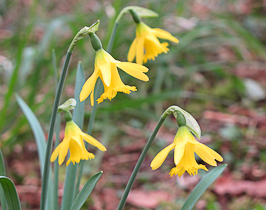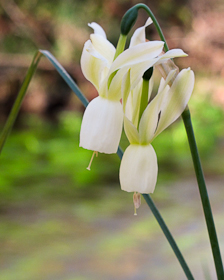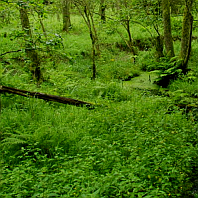On these late winter days, from early February to mid-March, when deciduous trees have not yet come into leaf, we can already see some unmistakable beautiful flowers on the riverbanks: daffodils.
 Also known by their Galician name amarelles, they are part of the Narcissus genus and the family Amaryllidaceae. They have a predominantly Iberian distribution and present many endemisms. There are five species in Galicia, easily distinguishable by their appearance.
Also known by their Galician name amarelles, they are part of the Narcissus genus and the family Amaryllidaceae. They have a predominantly Iberian distribution and present many endemisms. There are five species in Galicia, easily distinguishable by their appearance.
Which of these five daffodils can be seen in As Mariñas? Volunteers from Fragas do Mandeo have been scouring our large fluvial network trying to locate them, since three of them are listed as vulnerable species and their distribution throughout the region is not well known.
 Narcissus cyclamineus is unmistakable. Its tepals (this is the name given by botanists to their petals, because they do not differentiate from sepals) have a bright yellow colour and they turn backwards, separating from the corona (the characteristic daffodil trumpet, tube-shaped in this case). Although we could find it in very few places, it was not scarce at those specific locations. It is endemic in the North of Portugal and Galicia, with a poorly known distribution.
Narcissus cyclamineus is unmistakable. Its tepals (this is the name given by botanists to their petals, because they do not differentiate from sepals) have a bright yellow colour and they turn backwards, separating from the corona (the characteristic daffodil trumpet, tube-shaped in this case). Although we could find it in very few places, it was not scarce at those specific locations. It is endemic in the North of Portugal and Galicia, with a poorly known distribution.
In contrast, Narcissus asturiensis, is more often found although following the same pattern of being abundant in the locations where it is present —to the point that they could be detected from a distance— but being absent from long stretches of river with apparently optimal habitat. Though small in size like the N. cyclamineus, its appearance is typical of the Narcissi.
 A third daffodil we are looking for, Narcissus bulbocodium, is really peculiar. It stands out for its disproportionate crown, which earned it the Spanish common name of “trumpet of Medusa” (in English, hoop petticoat daffodil). It can also be found on riverbanks, together withN. cyclamineus and N. asturiensis, being more flexible in its choice of habitat; in fact, we can find it in meadows and oak woods away from watercourses.
A third daffodil we are looking for, Narcissus bulbocodium, is really peculiar. It stands out for its disproportionate crown, which earned it the Spanish common name of “trumpet of Medusa” (in English, hoop petticoat daffodil). It can also be found on riverbanks, together withN. cyclamineus and N. asturiensis, being more flexible in its choice of habitat; in fact, we can find it in meadows and oak woods away from watercourses.
A later bloom was that of the Narcissus triandrus. It is not uncommon, since we have even seen it in roadside ditches, but it is not as easy to find as the previous ones, because it has a much more discreet, pale colour that easily blends with the surrounding vegetation. It is an endemic species of the northern half of the Iberian Peninsula.
 We did not find the last of the Galician daffodils, Narcissus pseudonarcissus, but we cannot rule out its presence, since it blossoms later on (from March to May). It is the biggest of the five, with their typical shape, in which the tepals usually have a softer tone than the corona. In Galicia the subspecies nobilis and moschatushave been reported.
We did not find the last of the Galician daffodils, Narcissus pseudonarcissus, but we cannot rule out its presence, since it blossoms later on (from March to May). It is the biggest of the five, with their typical shape, in which the tepals usually have a softer tone than the corona. In Galicia the subspecies nobilis and moschatushave been reported.
Galician daffodils are protected by various local, state and European regulations. In the Galician Catalogue of Endangered Species N. cyclamineus and N. asturiensis are classified as vulnerable, as well as the subspecies nobilis of N. pseudonarcissus. The three of them are mentioned in Annex II of the Directive Habitats, N. triandrus being reported in the Annex IV and N. bulbocodium in Annex V.
The Narcissus genus is in a phase of speciation, that process of evolution that leads to the formation of new species by differentiation of their populations. For this reason, although we have said that they are easily identified by their appearance, for taxonomists (specialists in the classification of living beings) it is a complex genus still under discussion with regards to the definition of the various species. This is another reason to worry for its conservation in the As Mariñas area.



















